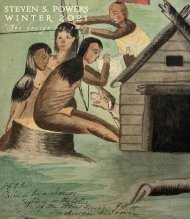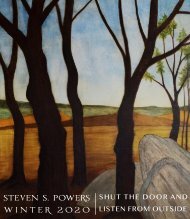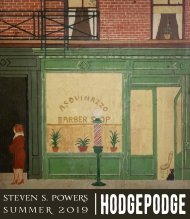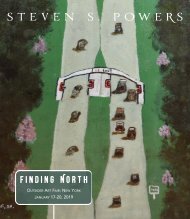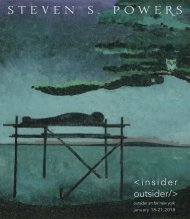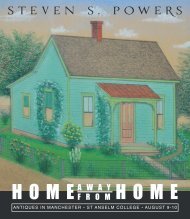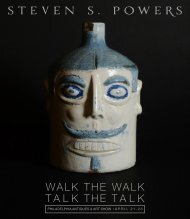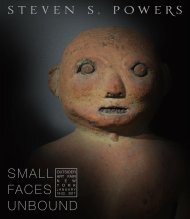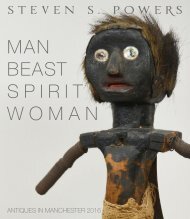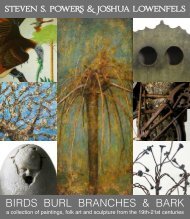NEEDLE • KNIFE • TORCH [&] BRUSH
Steven S. Powers presents, NEEDLE • KNIFE • TORCH [&] BRUSH, a collection of Outsider, Folk Art and good ol' Americana assembled for exhibition and sale at The Philadelphia Antiques & Art Show April 15-17 2016 with a gala preview party April 14. The Navy Yard, Marine Parade Grounds, Philadelphia, PA 19112. StevenSPowers.com for more information.
Steven S. Powers presents, NEEDLE • KNIFE • TORCH [&] BRUSH, a collection of Outsider, Folk Art and good ol' Americana assembled for exhibition and sale at The Philadelphia Antiques & Art Show April 15-17 2016 with a gala preview party April 14. The Navy Yard, Marine Parade Grounds, Philadelphia, PA 19112. StevenSPowers.com for more information.
Create successful ePaper yourself
Turn your PDF publications into a flip-book with our unique Google optimized e-Paper software.
coincidence, but on several occasions Roth mentions money<br />
and the Homer Lee Banknote Company. Given these interests,<br />
artistic talent and his unstable mind, the fraud may be tied to<br />
this Joseph Roth.<br />
At the turn of the 19thC and into the 20thC, institutions began<br />
using arts and crafts as occupational therapies—embroidery<br />
was one such craft. In thinking of the patience required for<br />
such involved and ambitious works, one can see how<br />
embroidery would slow down ones racing thoughts. One<br />
cannot frenetically scribble their mad rambling words—the<br />
deliberate action of threading the needle, pushing it through<br />
the obverse and reverse, step and repeat, forces one to<br />
consider their thoughts at a more manageable pace.<br />
It is during this time that we see embroideries and other<br />
artistic creations documented in Europe—most famously by<br />
Dr. Hans Prinzhorn, a German psychiatrist and art scholar.<br />
Because of the materials used, Roth’s work draws comparison<br />
to the work of Lorina Bulwer (1838–1912) who was a British<br />
needleworker and a patient at the Great Yarmouth Workhouse.<br />
Bulwer created embroideries with illustrations and copy also<br />
written all in capital letters and without punctuation to<br />
express her anger at her situation. Agnes Richter (1844-1918)<br />
a patient in a German insane asylum obsessively embroidered<br />
her straight jacket. Roth’s work also conjures up the colorful<br />
and obsessive drawings of Adolf Wölfli (1864-1930) of the<br />
Waldau Clinic in Bern, Switzerland, as well as James Edward<br />
Deeds, Jr. (1908-1987) who was in State House #3 in Missouri.<br />
The textile on the previous page is the earliest recorded and<br />
dates from August 27, 1905. It is entitled, the “REPORT.” It<br />
begins with name of Dr. West (who Roth refers to several<br />
times) and lists a number of vocations; Brikleker (bricklayers),<br />
Stonemeson (stonemason), Sourbuilthers (sewer builders), etc.<br />
Roth then declares that he wants to go into NYC with Dr. West<br />
to the Homer Lee Banknote Company. It ends by Roth stating<br />
that he wants to see President Roosevelt in Washington<br />
[about] “the gold and silver money mashinry [sic].” And signs<br />
the textile, “Joseph Roth = World Erloser (world savior).” Note<br />
that not only does he refer to himself as the redeemer; he<br />
decidedly uses the equals (=) sign!


![NEEDLE • KNIFE • TORCH [&] BRUSH](https://img.yumpu.com/55309753/4/500x640/2-needle-o-knife-o-torch-amp-brush.jpg)

